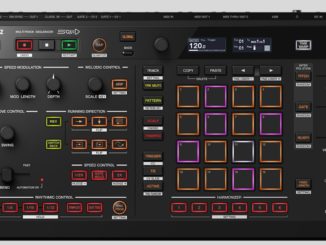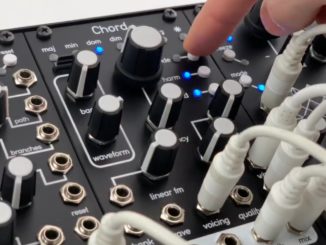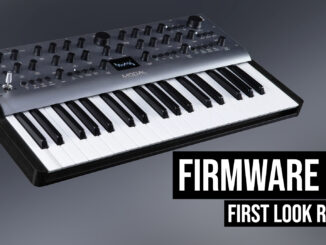Ellitone E64 melts a wavetable engine and an intelligent, self-composing sequencer into a handheld gaming console inspired Synthesizer
Some time ago the indie developer Ellitone from the US made a name for himself in the Synthesizer world with his Multi-Synth. The synth currently costs just under € 80 and offers a lot of synthesis power in the smallest space. The same developer now has a larger project called Ellitone E64, a Synthesizer and sequencer that looks like a handheld gaming console.
According to the developer, it delivers a wide spectrum of new sonic experiences achieved by a newly developed experimental approach to compose music and modulate parameters.
The initial idea for this musical instrument was to somehow find a way to break away from the struggle of composing musical sequences by hand. Practically every musical sequencing device available today provides the user with a blank canvas for which to compose upon. The user starts with nothing but a pencil tool and an endless blank piano roll grid before them. He must begin entering notes into the empty piano roll – slowly building chords and melodies one note at a time until a song begins to take shape.
A Rubiks-Cube Inspired Musical Theory Engine
Ellitone E[64] features an 8×8 LED matrix on the interface that is capable of creating advanced melodies. This musical theory engine is inspired by the legendary Rubiks-cube because each colored side of this cube represents a different musical composition element: scales, chords voicings, rhythms, and tonality.
The user can “twist” and “rotate” the cube by editing the values of 33 control parameters. The so-called cube matrix is not really shaken here but it can be virtually manipulated with the parameters. The results are interesting interactions that are translated into a highly flexible stream of polyphonic notation data.
It sounds super complicated but the engine requires 0% knowledge or understanding of musical theory to operate. So the E[64] builds melodies, complex chord structures, and mutating arpeggios for you just by playing around’ with the 33 control parameters. A total of 65 predefined“paths” determine the sequence and rhythm in which the sequencer triggers notes and chords. That’s not all. Also onboard is a modulation sequence for every parameter that works also automatically.
Digital Wavetable Engine
Under the hood is a 32-bit processor that outputs completely noise-free digital audio at 16-bits, 44.1 kHz. It features a 12-voice polyphonic digital wavetable synth engine with a wave-blending functionality. The 12 voices each consist of 2 separate oscillator layers (24 oscillators total). There are two layers (A & B) and each has its own waveform shape, tuning ratio, and envelope settings.
The users can choose a waveform for each layer from a library of 128 custom waveform shapes. It would be nice if you can also import your own waveforms but no info on that. The wave-blending function performs an automated ‘morph’ between the A & B waveform layers. This function can be used to achieve many interesting evolving tones and textures.
All 12 voices then run into an audio effect section with a lowpass filter and tape-styled delay. The latter is named “tape-styled” because the audio travels within the feedback path and is downsampled and filtered every time it passes through the feedback loop. This effect can add an extra layer of endless lo-fi motion using longer delay times and a bizarre type of ambient reverb when using shorter delay times.
Interesting fact: the synth can’t save patches and generates a new randomized patch every time it is powered on. This is the starting point with which you build sounds and melodies
Gaming Interface
The Ellitone E64 interface and hands-on control of the E64 are quite obviously inspired by portable video game consoles. I can only agree with the developer. It looks like a Gameboy Synthesizer. On the left side, you have 4 buttons ( D-pad cursor) and on the right increase/decrease buttons. The developer says that the control layout is designed for an extremely fast sound editing experience.
Connections & Battery Powered
The final audio is output to a 1/8 inch (headphone) audio jack located on the back of the device. also located on the back of the device is a 2.1mm DC barrel jack for powering with a wall adapter (7.5V INCLUDED). The E[64] can also be powered by six AAA batteries that are inserted directly into the back of the device. A bit pity, the device is an entirely standalone instrument and doesn’t offer to sync or clocking options. However, it is possible to add CV and trigger functionality in the future.
At first glance, an interesting new experimental Synthesizer. Above all, the fully automated features make me very curious about the device. The fully automatic system can also deter many musicians who love to build sequences etc from scratch. Here the work is done by the engine. Nonetheless, an interesting concept for a synth.
Ellitone E64 will be available in June for 310,05€. The first batch of 20 units will begin shipping between June 16 and June 23.
More information here: Ellitone

![Ellitone e[64]](https://synthanatomy.com/wp-content/uploads/2020/05/Ellitone-e64.jpg)
![Ellitone e[64]](https://synthanatomy.com/wp-content/uploads/2020/05/Ellitone-e-64.jpg)



It’s really cool! Sad that it cannot send those sequences to other devices.
I LOVE IT!!!!!! I just ordered one!!! Can’t wait to get it!!!
I agree on it being sad about the syncing and I would think transposition through MIDI. It sounds really nice, but at that price without those capabilities it feels like it can’t be integrated into a nice music set-up; no drums for example…
A “self composting” sequencer? You guys need to proofread your reviews.
I rely on his comments. Synth Anatomy is not “guys”, it’s just myself, one guy making news, reviews, videos… etc. All without any help. Mistakes are human and happen sorry. Cheers 😉